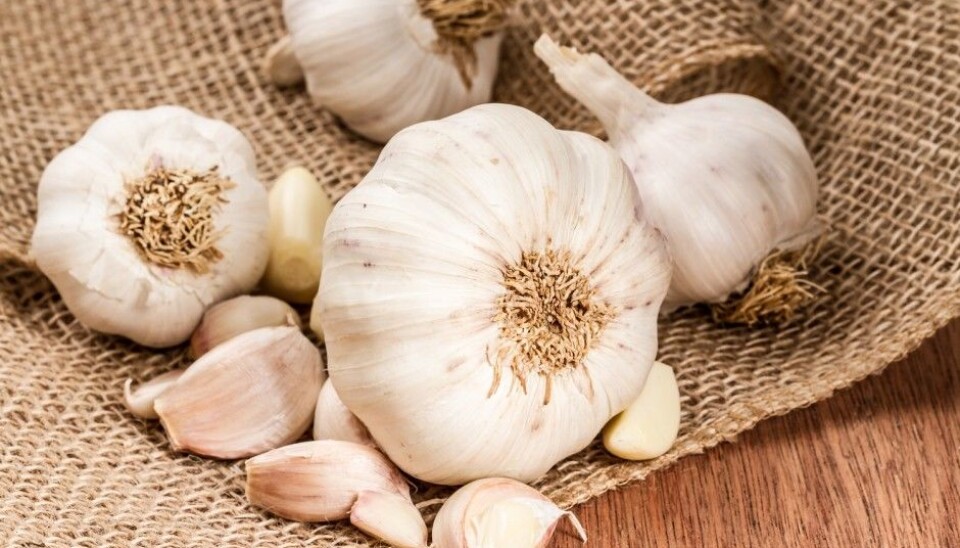
Substance from garlic combats chronic infections
A molecule found in garlic inhibits the defence mechanism of bacteria, boosting the power of antibiotics and the human immune defence, according to a Danish study.
The molecule ajoene has been shown to destabilise the communication system of harmful bacteria. Used in harness with antibiotics it can tackle infections that are otherwise tough customers.
“We are going all-out to prepare this method as a new treatment for patients who do not have, or haven’t had, good prognoses,” says Tim Holm Jakobsen, at Copenhagen University’s Department of Immunology and Microbiology.
Garlic is popularly considered to be a healthy foodstuff. Many studies have indicated that garlic does have healthy qualities; it helps lower cholesterol and has a mildly positive effect on the immune defence system and even a certain preventive clout against cancer. The Danish researchers now plan to create a medication based on a natural compound from this plant.
Jakobsen and other Copenhagen University scientists have researched the effect of garlic on bacteria for over ten years. They have found that a garlic extract seemed to inhibit bacteria and further studies led them in 2012 to home in on the sulphur-rich chemical compound ajoene.
Ajoene is produced most efficiently from allicin, a compound in garlic which has been shown to have promising effects. Now the researchers have studied the mechanism at the molecular level.
“We now have the knowledge needed to make a pharmaceutical product and test it on patients,” says Jakobsen.
When bacteria communicate
Bacteria generally like to bunch together. They communicate by creating a protective, slimy membrane around one another, called biofilm. When harmful bacteria do this they can cause a lot of damage.
Antibiotics and our immune defence have trouble penetrating biofilm and chronic infections can result. Bacteria can evolve genetically, exchange genes and develop resistance.
The substance extracted from garlic does not kill the bacteria on its own, but it harms their defence mechanism, the biofilm.
“Our goal is to get in there and inhibit the communication among the bacteria. We are not aiming at killing the bacteria, but rather to harm their communication. Ajoene has this effect,” says Jakobsen.
Ajoene inhibits the tiny RNA molecules in bacteria, undermining their ability to mutually communicate. Our natural immune defence mechanisms can mount a stronger attack when the biofilm is damaged. Moreover, weakened biofilm makes bacteria more vulnerable to antibiotics.
The question that arises, however, is: Doesn’t this compound also inhibit beneficial bacteria in our bodies too?
“No,” says Tim Holm Jakobsen.
“Bacteria have different communication systems and this compound works against typical systems used by harmful, pathogenic bacteria. Friendly bacteria have a different communication system.”
Human testing
The researchers have used the compound against two pathogenic bacteria called Staphylococcus aureus and Pseudomonas aeruginosa. The first, commonly known as yellow staphylococcus, is normally not a dangerous pathogen, but it can be very perilous for persons with strongly reduced immune defence systems, especially when infected by the feared multi-resistant type MRSA.
The other bacteria, Pseudomonas aeruginosa, can cause serious infections too and is known to be hard to treat with antibiotics. It is the most common bacteria in lung infections among persons with cystic fibrosis.
“The reason why we have focused on these two in particular is because these bacteria are found in very many infections. We have tested against other pathogenic bacteria but most of our efforts have been on these two,” explains Jakobsen.
The researchers found that ajoene was good at controlling the virulence of the two pathogens.
The first medication based on ajoene will be used to treat cystic fibrosis patients. But Jakobsen thinks it can be helpful in fighting various other types of infections later on.
“If the clinical tests are successful, this will be the first time anyone inhibits the bacterial communication system in this way. It is truly exciting.”
Should we eat garlic?
Does this mean we should eat more garlic?
“Eating more garlic will not help rid you of an infection. One would have to eat incredible amounts, and that would actually be unhealthy,” says Jakobsen.
He explains that the medical experiments involved the garlic compound in a concentrated and synthetic form.
“But I am not saying that garlic isn’t a healthy plant to eat. It is known to have a certain immunity-boosting effect.”
-------------------------------------
Read the Norwegian version of this article at forskning.no
Translated by: Glenn Ostling




